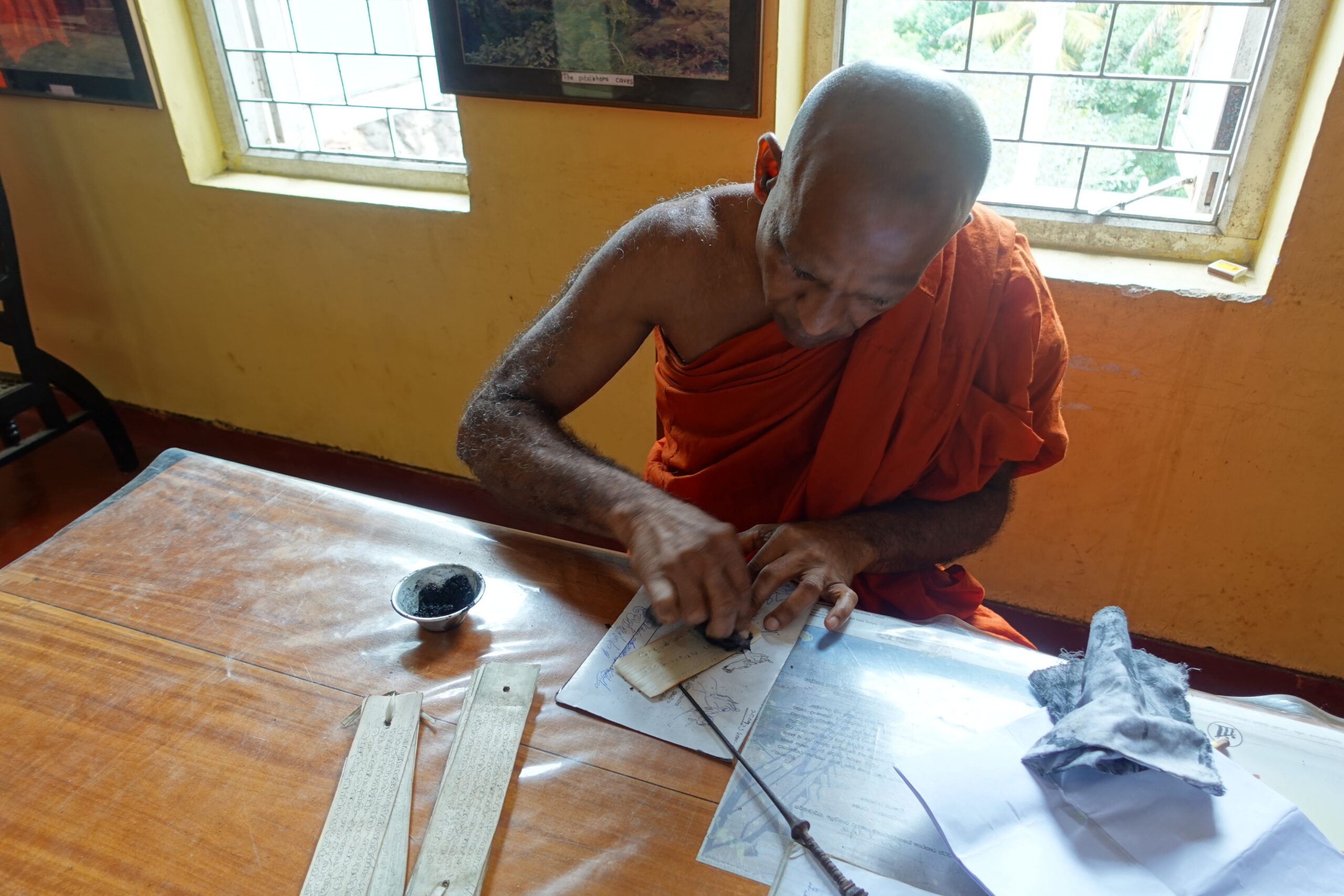Travels to Buddhist sites in India and Sri Lanka (40)
Visiting Alvihara - A historical temple where Buddhist scriptures were first transcribed! Did transcription give birth to later Mahayana Buddhism?
After enjoying Sigiriya Rock in the morning, I left for Kandy, the final destination of the day. The journey from Sigiriya to Kandy took about three hours. On the way, I decided to visit a place where an important event took place that had a bearing on Sri Lankan Buddhism and, by extension, on all of world Buddhism.
That is what Alvihara is all about.
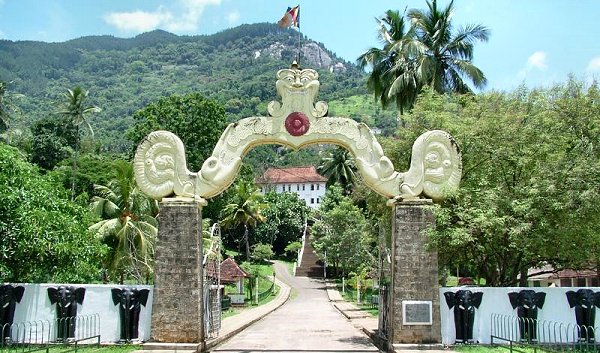
This temple became famous in history because it was here that the first copying of sutras in the history of world Buddhism took place. About thisA History of Buddhism in New Asia 04: Sri Lanka and Southeast Asia, Buddhism in Stillness and Motion.The following is the explanation in the following section.
A landmark project in the history of Sri Lankan Buddhism was the "transcription of Buddhist scriptures" during the reign of King Vattagamani Abhaya in the first century BCE. The teachings of the Buddha, which until then had been transmitted by rote recitation, were transcribed into written form.
Although the reason why the "copying of Buddhist scriptures" was necessary is not discussed in the literature, the following circumstances are assumed to have existed.
First, Sri Lanka's history has always been subject to foreign invasions, especially from South India. When the reigning king is not Sinhalese, Buddhism continues to decline, and not only that, there are fewer bhikkhus to recite and retain Buddhist scriptures.
Second, there was the experience of an unprecedented famine that lasted for twelve years. During this period, the number of bhikkhus dwindled, and the reality of the Shobo Gomochi Order became corrupt.
And it was the erection of the Avayagiri temple, which became a rival to the Mahavira temple (E.W. Adikaram, 1946).
The Mahavira temple was built in Anuradhapura by King Tissa, who introduced Buddhism to Sri Lanka, and the sect centering on this temple is called the Mahavira school. The sect centering on that temple is called the Mahavira sect. The Abhayagiri sect was formed by a split from the Mahavira sect. I will talk more about this Buddhist sect in Sri Lanka in a later article.
In addition to these causes, there were probably political factors as well. The same Sinhala king would not necessarily support only the Mahavihara temple, especially in the building of the Abhayagiri temple. King Vattagamani Abhaya is a common example. There may also be differences of opinion within the same Maha Vihara temple school. It is easy to see that some of the bhikkhus understood the great role of Shobo Kyuju.
For these reasons, a group of 500 volunteer bhikkhus of the Mahavihara Monastery School copied Buddhist scriptures at a cave in the central part of the island, in what is now Arvihara, Mataray District, in order to make the Dharma a long-lasting presence.
Some line breaks have been made to make it easier to read on smartphones, etc.
New Asian Buddhist History 04: Sri Lanka and Southeast Asia, Still and Moving Buddhism, edited by Yasuaki Nara and Masahiro Shimoda, P121-122, Kosei Press, Inc.
Although not mentioned within this citation, it is believed that this copying of Buddhist scriptures in Alvihara was the first not only in Sri Lanka, but also in mainland India. It was in the first century B.C.
In Indian and Sri Lankan religious traditions, scriptures were basically recited by heart. These scriptures were then passed down orally from master to disciple. In other words, there was no idea of writing down the words. This style of oral transmission, which could be called an ironclad rule, was broken by the transcription of Buddhist scriptures. This had a huge impact on later Buddhism. I will talk about this later.
Let me now take you on a tour of Alvihara.

This is the entrance to Alvihara.
At first I was surprised to see a large number of orange flags flying, but I was told that the chief abbot of this temple passed away a few days ago, and these flags were flown for that reason.

As called the Cave Temple of Alviharra, this temple is also integrated with the rocky mountain.
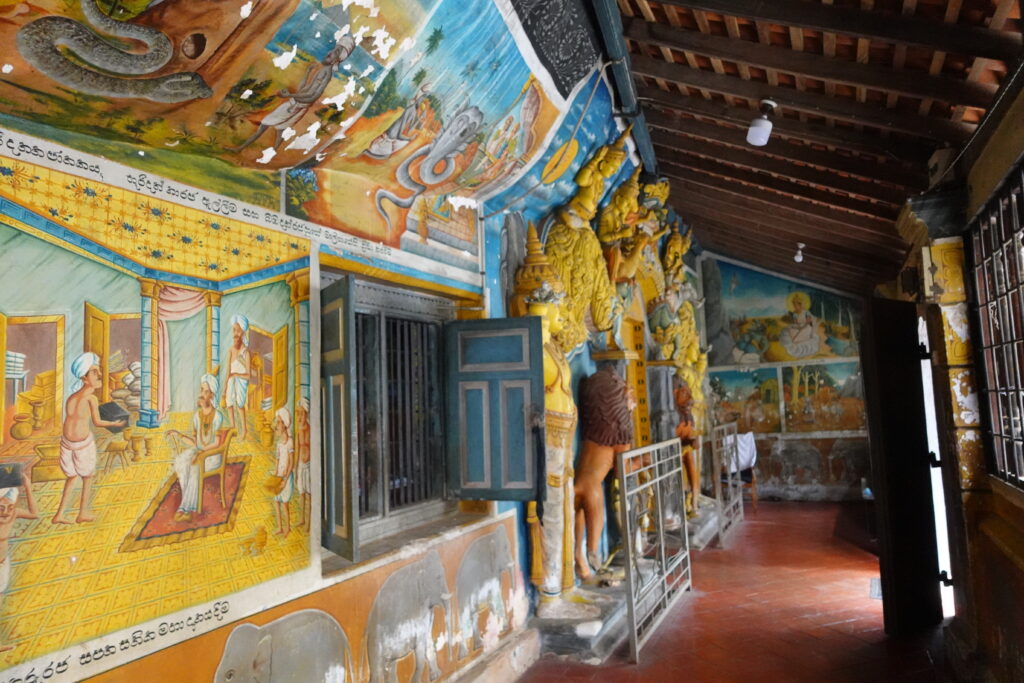
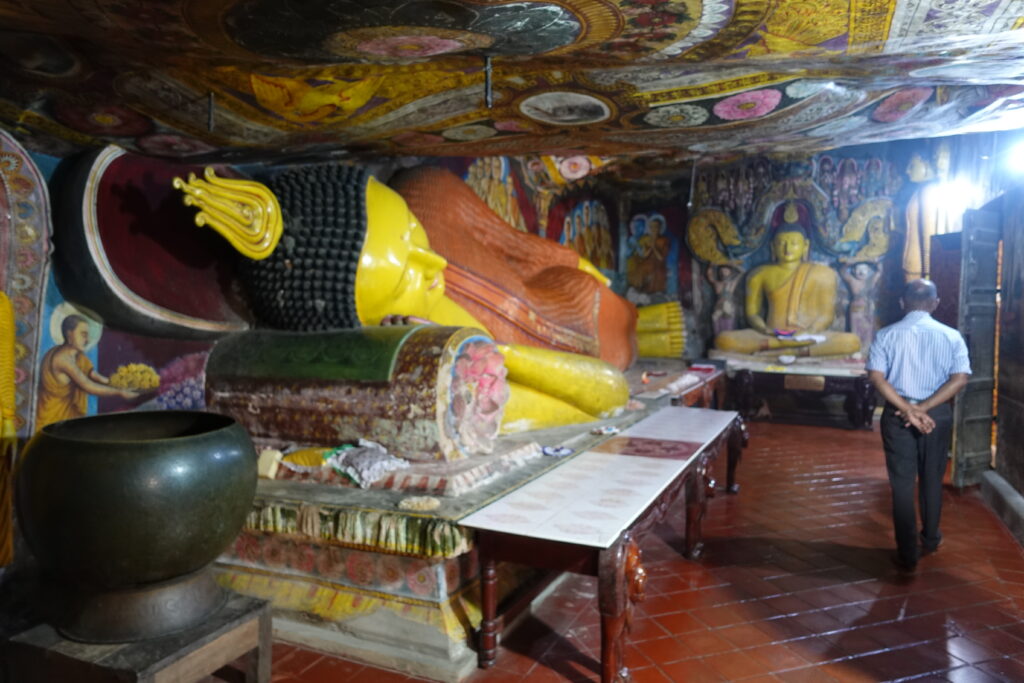
The interior of the hall is, as usual, newly and beautifully repainted.
And the temple is famous for the following mural painting.

This temple is also famous for its hell pictures. The picture above is of sinners being tortured by prisoners of hell.

The basis of the hell pictures is probably the "Nensho Sutra," which is also the basis of hell pictures in Japan. Therefore, when I look at this picture, even I can recognize it as "Oh, this must be that hell that is preached there.
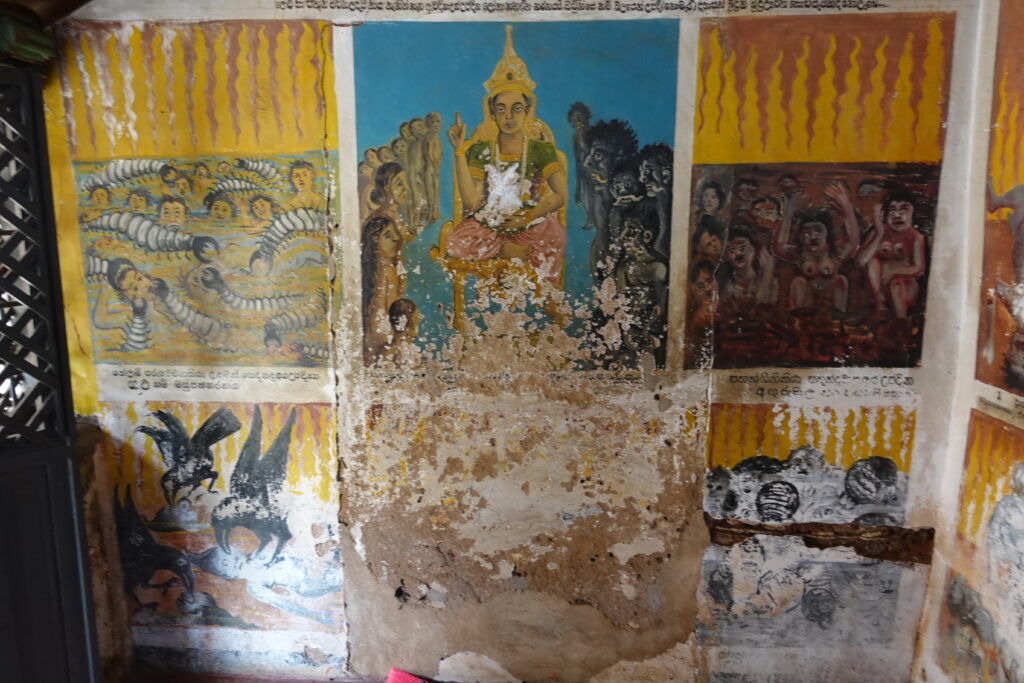
There are various hells, such as being eaten by giant insects in a pond, being pecked by birds and animals, and being submerged in a boiling pool of feces and urine.
(30) A Brief Explanation of Theravada Buddhism in Sri Lanka - A Word on its Differences from Japanese Buddhism.As I mentioned in my article "The Sri Lankan Buddhist tradition," which preaches "karma and self-reward" and places importance on reincarnation, the depiction of such hell pictures must have been a horrifying experience. In Japan, too, there is a long tradition of preaching that asks questions about life through such hell pictures, and I was reminded of the fact that this is something that is common throughout the world.
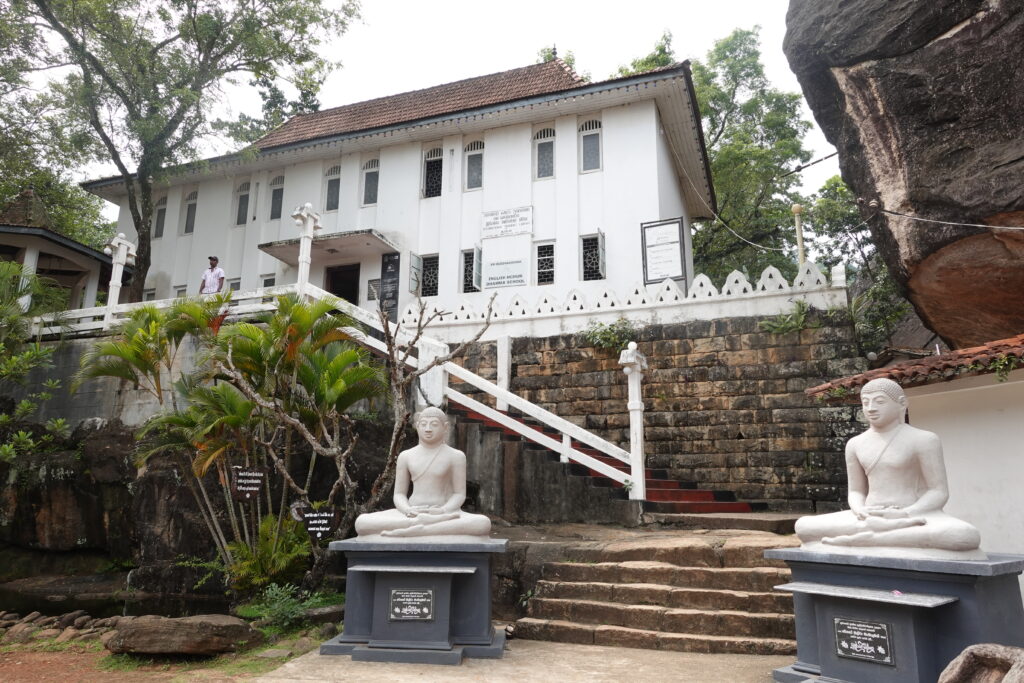
And here is the building that serves as a monastery and exhibition hall.
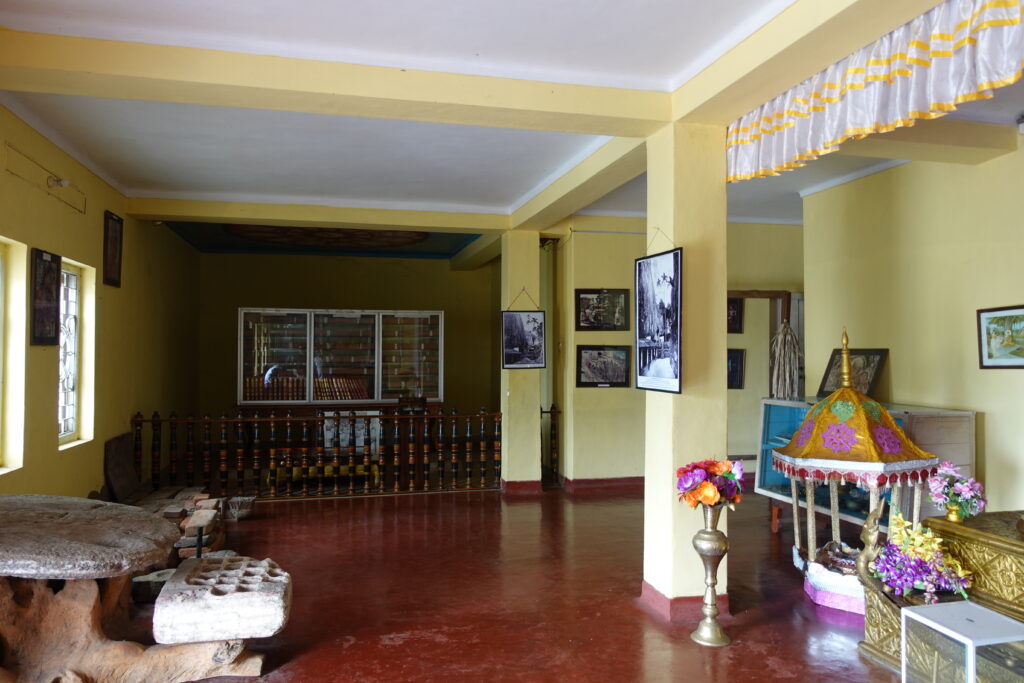
This is the inside of the museum. The director of the museum has passed away, and the staff in charge seems to be gone now.


Here is a scripture made of palm leaves. They are bundled together in a rectangular shape. The life span of these scriptures is said to be two to three hundred years at the most. Therefore, the scriptures that remain today have been rewritten many times.
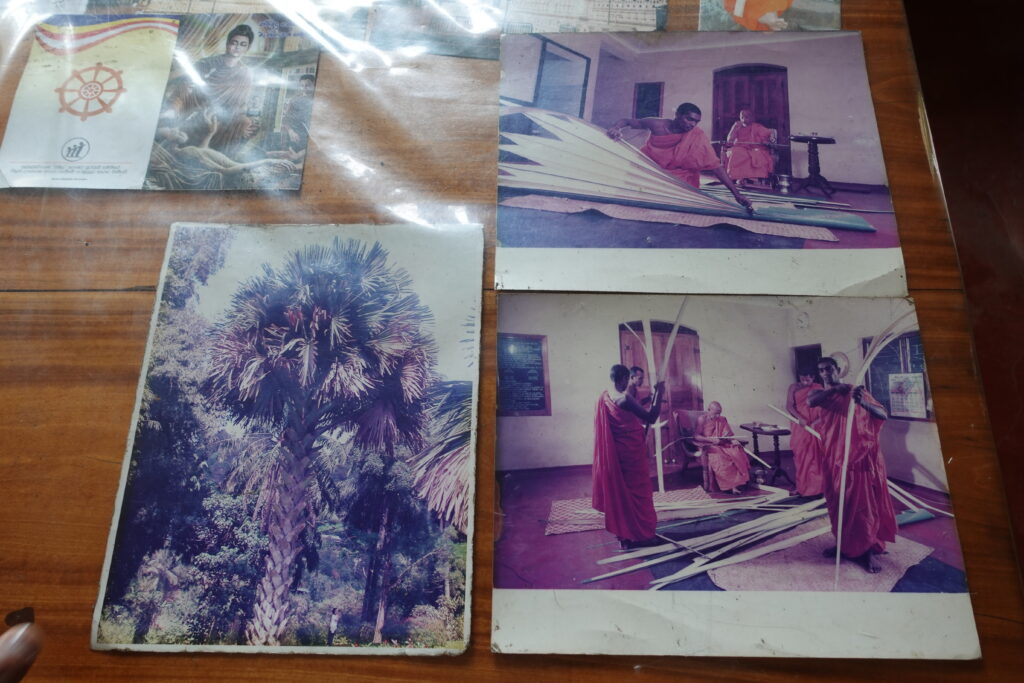
Here is a photo of the palm tree and its production process.

These are dried palm leaves. This is then arranged into the rectangular shape shown earlier and scribbled on top of this.
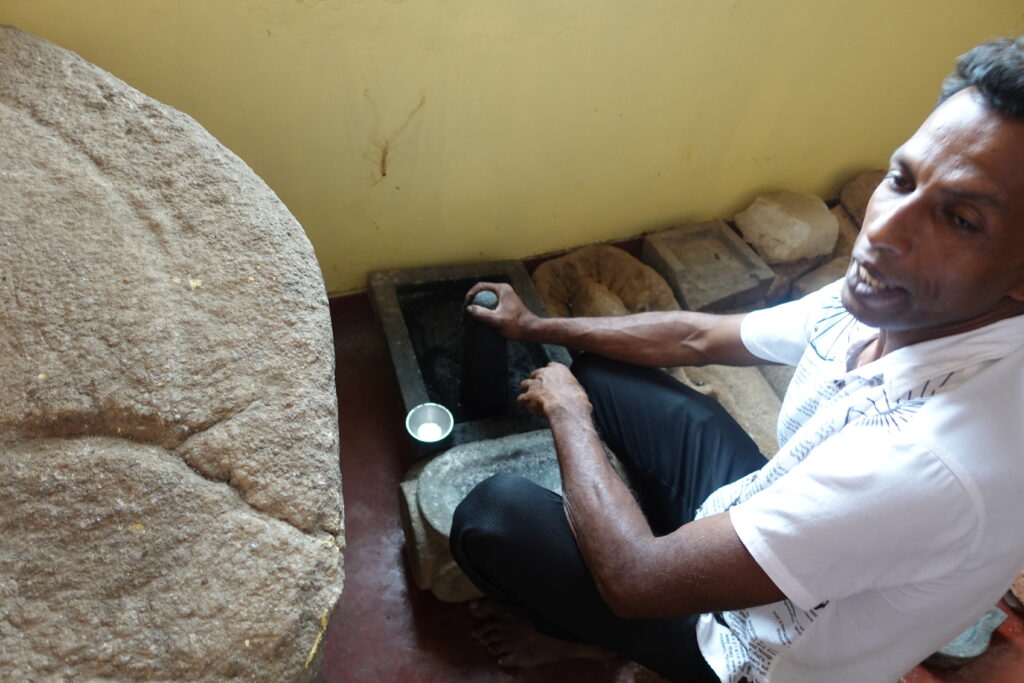
Thanks to the guide who read the monastery, we will now actually write letters on palm leaves. This picture shows the preparation of ink for the calligraphy.
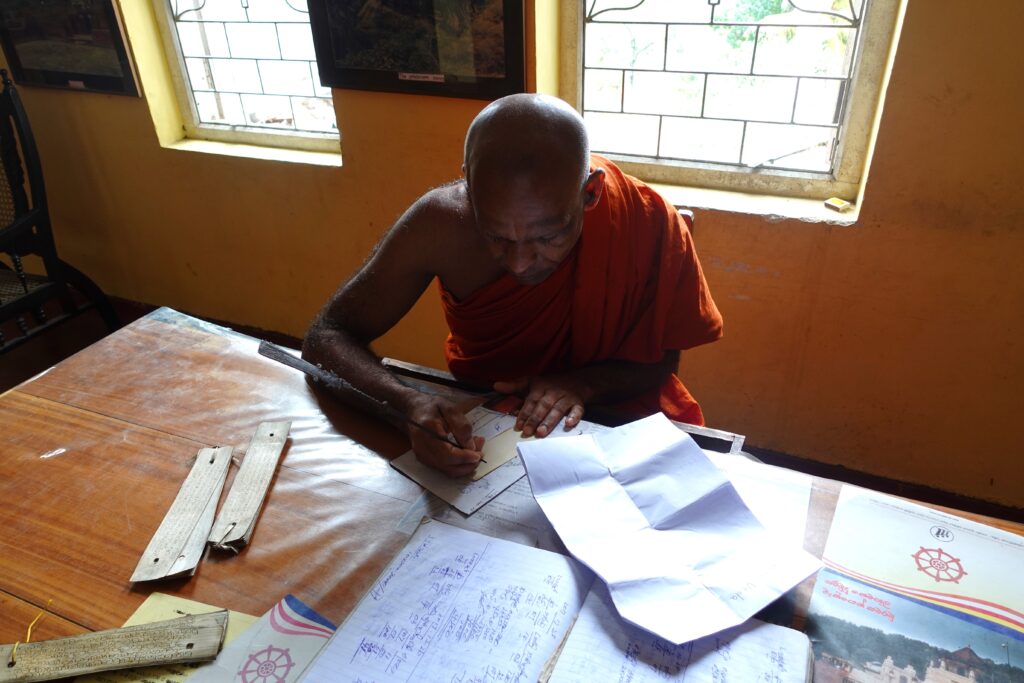
A monk from Alvihara Monastery came and began the demonstration. He used an iron pen to carve letters on the palm leaves that we had just seen.
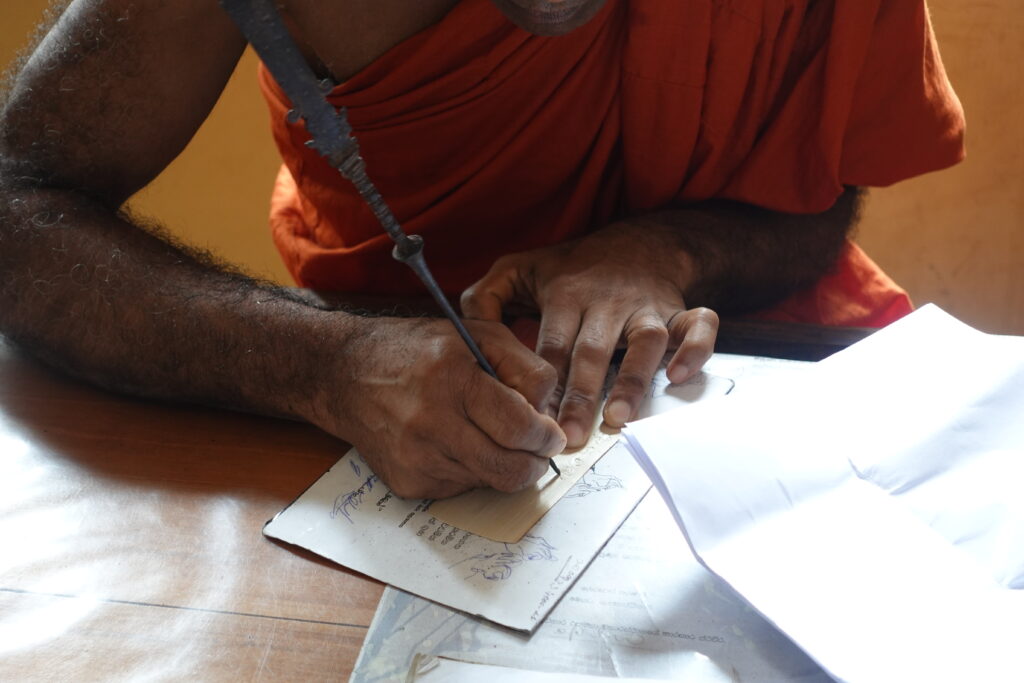
At this stage, it is more accurate to call it carving letters rather than writing them.

Here is the iron pen and the palm leaf. The tip of the pen is sharp and is used to engrave the surface of the leaf.
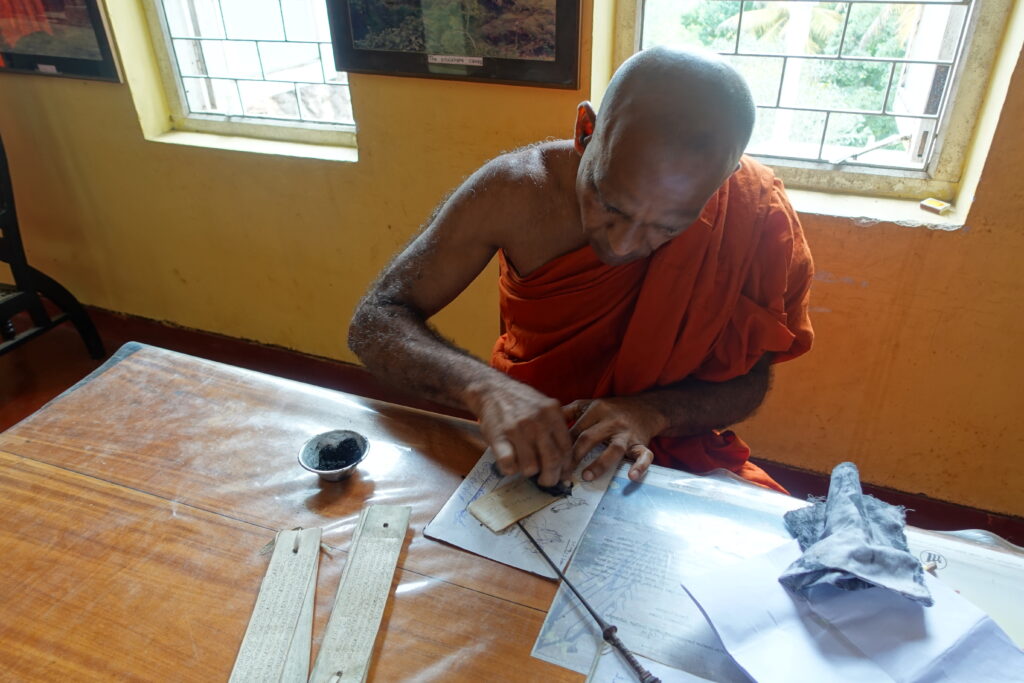
Then, from here, the entire leaf is rubbed with the ink prepared earlier.
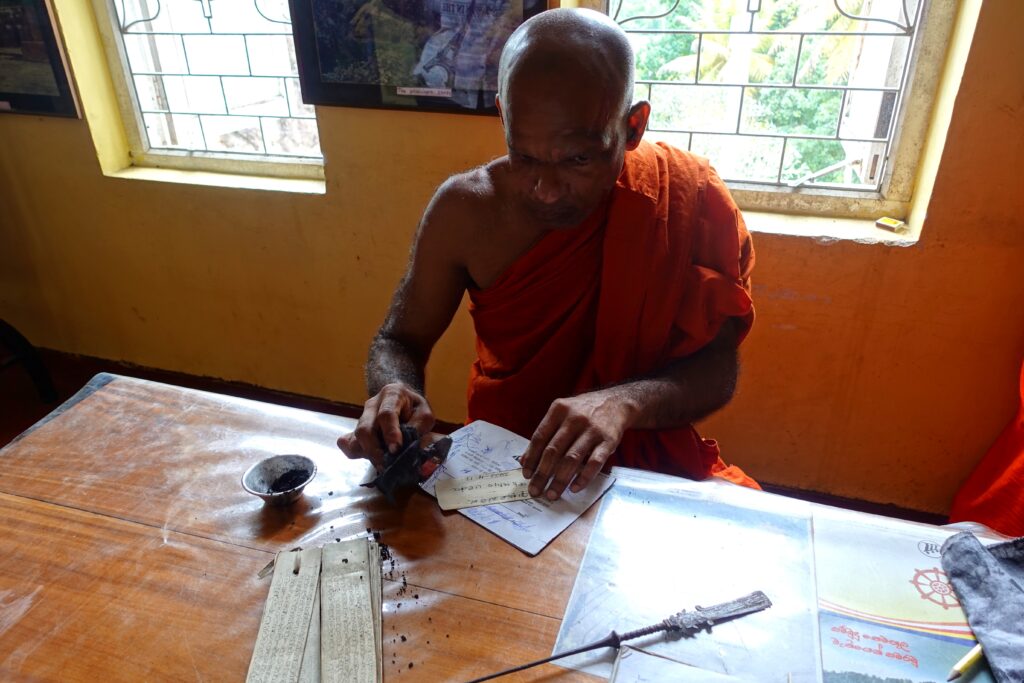
The ink then firmly penetrates the grooves carved by the pen, and the letters emerge.
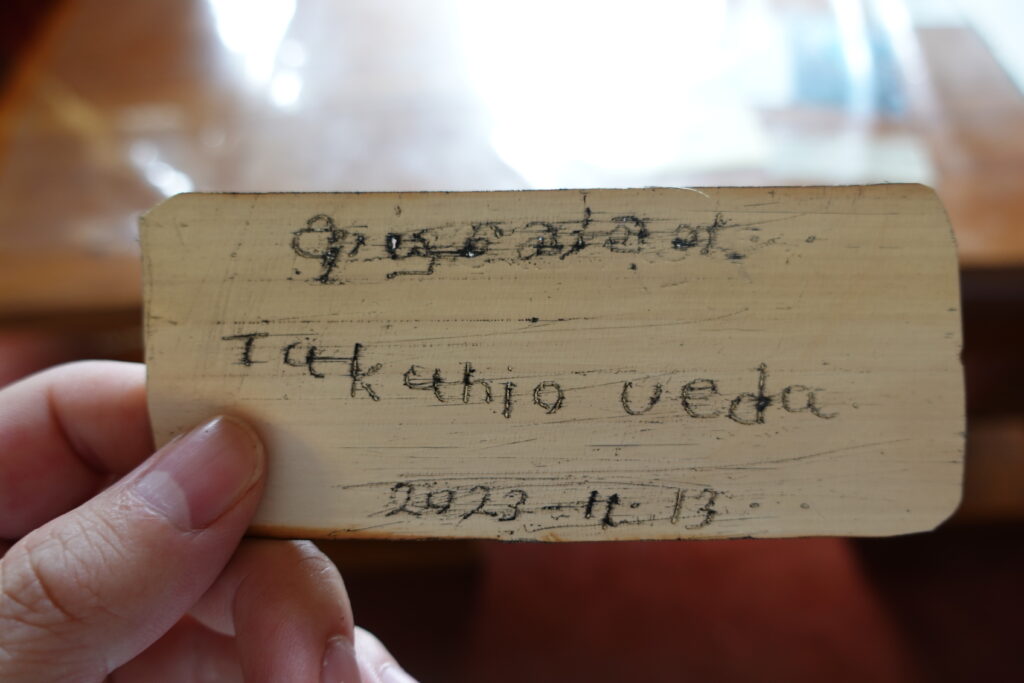
This is the end of the project. I don't mind that the name is "Takahio Ueda".
This is how Buddhist scriptures were also transcribed. It was a very gratifying experience for me to see the production process up close.

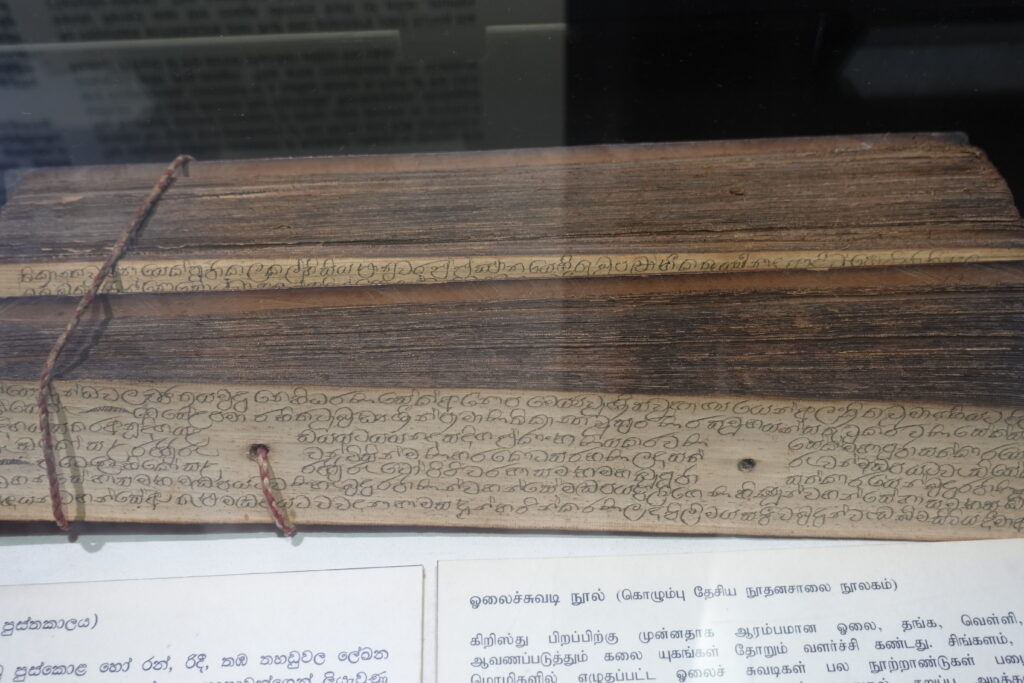
Now that we have looked at Alviharra's copy of the scriptures, let us now get to the heart of the matter.
The crux of the matter is that "the first copying of sutras in the Buddhist world may have been a major factor in the birth of the later Mahayana Buddhist scriptures.
The Mahayana Buddhist scriptures, which are said to have originated around the first century A.D., are the core texts of Japanese Buddhism, including the Prajnaparamita Sutra, the Lotus Sutra, and the Amitabha Sutra. It would take a long time to explain what Mahayana Buddhism is, but it is highly likely that the scripture copying that began in Sri Lanka in the 1st century B.C. had a great influence on the birth of these Mahayana scriptures.
As mentioned earlier, in Indian and Sri Lankan religious circles, it was assumed that the scriptures were to be recited by heart, and it was not even imagined that they were to be transcribed. This is true not only of Buddhism, but also of Hinduism and Jainism, and was a natural common sense in the Indian cultural sphere.
In such a situation, as we have seen, the Mahavira school in Sri Lanka faced a crisis even in the transmission of Buddhist teachings, and they had no choice but to start sutra copying.
The problem is what comes after.
The previously taboo practice of sutra copying began to take place in the Indo-Sri Lankan Buddhist community, something previously unimaginable.
To think about this, we must first consider the book by Baba NoritoshiBuddhist Orthodoxy and Heresy: The Establishment of the Pali Cosmopolis."Let's look at the following commentary on
The Indian Buddhist scriptures were originally passed down orally. For about five centuries, Buddhist scriptures were transmitted only orally, and only around A.D. did transcription begin. However, transcription was only a supplementary means of transmission, and the oral tradition remained the core of Buddhist scripture transmission.
The fact that the Buddhist scriptures were oral traditions has to do with the fact that they are texts to be memorized and practiced, not books as external objects. For example, the original meaning of "dharma" referring to Buddhist scriptures is "something to be retained," and the original meaning of "teaching dharma" is "mastery," both meaning "something to be memorized, acquired, and practiced. The word "Agon" literally means "oral transmission. Those who learned these Buddhist scriptures well were called "tamon," and their disciples were called "koei-hon. These terms well indicate that the study and practice of oral texts was the practice of Buddhism. (omitted).
Because the Buddhist scriptures were passed down orally, the objects of devotion in Buddhism were the three treasures of "Buddha," "Dharma," and "monks," and were not limited to one. The "Dharma" continued to exist through the transmission of the Buddhist scriptures by the ordained order (monks), and the recitation of the "Dharma" brought the Buddha, who had already passed away, vividly before the audience.
*Some parts of this book, such as the original language of words, have been abbreviated and quoted.
University of Tokyo Press, Baba Noritoshi, Buddhist Orthodoxy and Heresy: The Establishment of the Pali Cosmopolis, p. 31
First of all, it is important to note that even if copying of Buddhist scriptures began, it did not become a mainstream activity, but only a supplementary means.
And it is important to note here that in the Indian tradition, "words" were "sacred" beyond mere words. For more on the connection between words and religion, see Yuto Kawamura's bookThe Word and the Spell: Unraveling Vedic Mythology."In Buddhism, too, the words of the Buddhist scriptures are the very essence of sacred power, as explained in detail in
And the only way to learn the sacred words is to be ordained and become a member of that cult. This is because, since they are not written down in writing, one must learn them directly from those who know the Buddhist scriptures. This is why Buddhists revere the three treasures of Buddha, Dharma, and monks (the Order). It is the role of Buddhist monks to pass down and memorize the scriptures from master to disciple from generation to generation, and this is the very essence of Buddhist practice itself.
Walter J. Ong's "The Culture of Voice and the Culture of Writing" makes the following interesting points about this oral culture of master-slave transmission.
A society in which language functions solely as a voice requires that people say over and over again what they have patiently learned over the years with a great deal of energy.
As a result, the spirit takes an extremely traditionalist and conservative stance. Naturally, this spirit prohibits intellectual experimentation.
Knowledge is a rare and precious thing, and knowledgeable elders who have preserved their knowledge in a specialized way are highly valued in this society. They know the stories of old times and can tell them.
By storing knowledge outside the mind, that is, by writing and even printing, the value of these erudite elders, who are reproducers of the past, is diminished, while the value of the young, who are discoverers of something new, is increased.
Some line breaks have been made to make it easier to read on smartphones, etc.
Fujiwara Shoten, Walter J. Ong, translated by Naofumi Sakurai and others, Voice Culture and Letter Culture, p. 92
This is precisely the case in the religious world of India and Sri Lanka. In the strict Hindu sects, master-son transmission is still emphasized, and the scripturesRig Weda."is still recited today.
Similarly, in Buddhism, a great deal of energy was spent on this kind of transmission of knowledge. One strategy is to simply repeat words in a way that makes them easy to memorize. Here is an example.
68. Strive to achieve the highest purpose, be not timid in mind, be not slothful in deed, be firm in action, be equipped with physical strength and wisdom, and walk alone like a rhinoceros horn.
71. Walk alone like a lion not startled by sound, like the wind not caught in a net, like a lotus not polluted by water, like the horn of a rhinoceros.
Iwanami Shoten, Nakamura Gen translationBuddha's Words.I, chapter on snakes, 3. Rhinoceros horns p21, 22
This is an excerpt from a sutra that is said to be the closest to the words of the founder Buddha, but the phrase "Walk alone like a rhinoceros horn" is repeated many times to make it easy to memorize. It is because of this culture of oral tradition that most of the early sutras are based on the repetition of such simple phrases.
And as mentioned in the commentary above, the vast amount of energy used to memorize means that there is little room for creative thought. This is one of the reasons why the Traditional Order has been able to maintain its teachings, even though it was never intended to be creative in the first place.
However, this is where the taboo-breaking activity of "copying" was born.
What this created was precisely the room to analyze, study, and create new teachings. Let us continue with the commentary.
This is because research itself has to do with writing. Almost all thinking, including thinking in primary voice cultures, is analytical to some degree. That is, thinking breaks down its material into its various components.
However, it is impossible to abstractly order, classify, explain, and analyze (i.e., study, as it were) various facts and true or false statements without writing and reading them.
Those who live in a culture of primary voices (omission) learn much, acquire much wisdom, and practice it. But they do not "study.
Some line breaks have been made to make it easier to read on smartphones, etc.
Fujiwara Shoten, Walter J. Ong, translated by Naofumi Sakurai et al, Voice Culture and Letter Culture, p. 26-27
By writing, I no longer had to rely on memorizing the entire text of the Master-Son Sangha. It also allowed him to devote his time and energy to other things. Moreover, by writing, we were able to see and compare various concepts at the same time and contemplate them freely. This was a decisive departure from the traditional way of doing things. Walter J. Ong further commented on this.
Those who can read and write can no longer adequately imagine what language means to those who belong to a purely vocal culture who do not know how to read and write.
Fujiwara Shoten, Walter J. Ong, translated by Naofumi Sakurai and others, Voice Culture and Written Culture, p. 34
In other words, those who have used letters will live in a completely different world than those who live in a world of only voices.
In this way, a completely different way of thinking was formed through the copying of Buddhist scriptures.
Of course, as mentioned earlier, oral tradition was still the mainstay of Buddhist teaching after that. Transcription was only an adjunct and was not treated favorably. That is why it took so long for the Mahayana scriptures to be born, and why it took so long for them to gain in power.
This copying of Buddhist scriptures also coincided with the later start and development of the creation of Buddhist statues, which began around the 1st century A.D., and also gave rise to the new concept of the merit of "scripture copying. The teachings that were to be recited by heart were transformed into teachings to be "read and written.
Park Denshuku in Komazawa University Bukkyo Gakkai Ronbunshu No. 32, published in October 2001.Was there a fourth rally?"I recommend the paper, "The Process of the New York City Market," which explains this area in an easy-to-understand manner. In the concluding section of the paper, it is summarized as follows
The scriptures became more widely available and accessible to lay believers, and the practice of faith became possible at the individual level through the transcription and recitation of the scriptures, rather than the group, organized form of faith that had previously been based on the oral teachings. (The scriptures were then made available to the public, and the practice of faith became possible on an individual level.)
The fact that transcription took place was also one of the critical factors that led to Mahayana Buddhism and influenced the form of sutra transmission as a new way of practicing Buddhism.
Park Denshuku in Komazawa University Bukkyo Gakkai Ronbunshu No. 32, published in October 2001.Was there a fourth rally?".
It seems to me that "from the group organization of a religious order to faith on an individual level" is a very important point. I think this is a big issue for us Japanese Buddhists. Although there may be an image that "Mahayana Buddhism = Buddhism to save all people," it can also be seen from the aspect of faith at the individual level of each person.
Shinran Shonin, the founder of Jodo Shinshu, also expressed his salvation by Amida Buddha as "Shinran alone is the reason. This may be a subject for my future research.
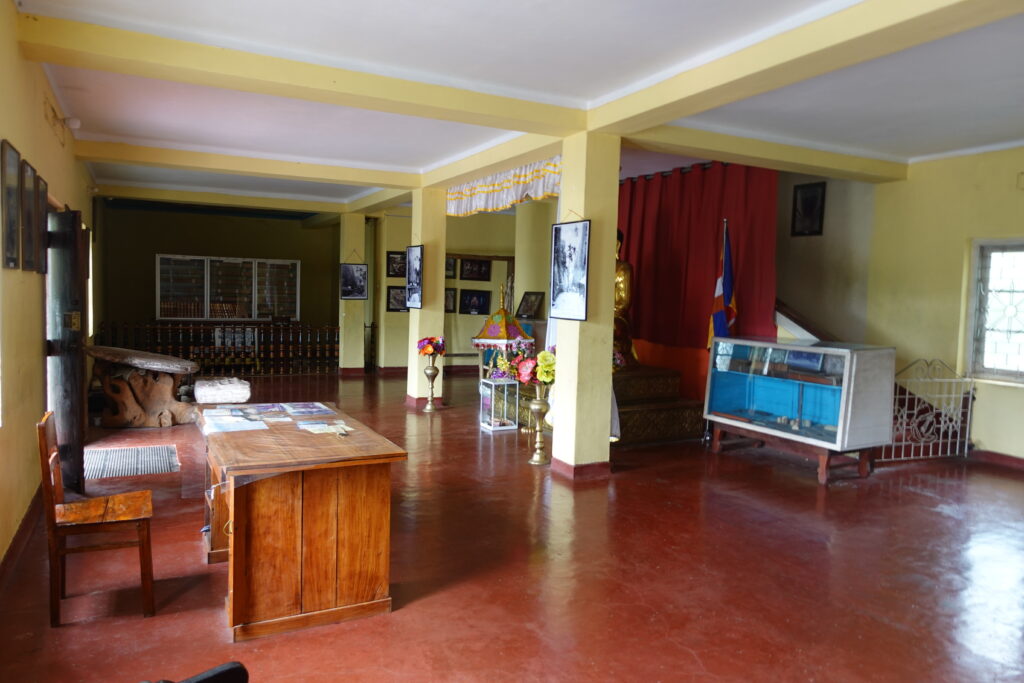
The experience at Al Vihara was indeed an interesting one.
Let us now head for Kandy, the ancient capital of Sri Lanka.
*Below is an article with reference books on India and Sri Lanka that we have referenced in this travelogue. Please refer to them.
periodA list of recommended reference books to help you learn about Indian history, religion, and culture."
periodA list of recommended books for "those who want to know more about Indian Buddhism."
periodA list of recommended books to help you get to know the Buddhist country of Sri Lanka."
Next Article.
Click here to read the previous article.
Related Articles











